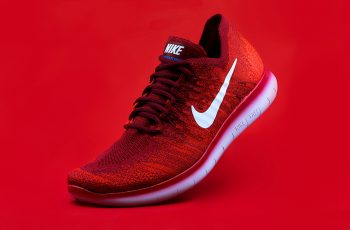You’re passionate about running and looking to make a positive impact on the environment. Well, you’re in luck! In this article, we’ll explore the world of eco-friendly initiatives and delve into the realm of sustainable running sneaker options. Say goodbye to the traditional sneaker manufacturing processes that harm the environment, and say hello to innovative materials and production methods that prioritize sustainability. Whether you’re an avid runner or simply looking for more conscious choices, this article will guide you towards eco-friendly running sneakers that not only support your active lifestyle but also help protect our planet.
1. Material Choices
When it comes to choosing sustainable running shoes, the material choices play a crucial role in reducing their environmental impact. There are several options available that prioritize eco-friendliness and promote a more sustainable future.
1.1 Recycled Materials
One of the most popular and effective ways to create sustainable running shoes is by using recycled materials. This approach involves repurposing materials that might otherwise end up in landfill sites. Recycled polyester, for example, can be used to create the upper part of the shoe, reducing the need for virgin materials. Recycled rubber can also be used for the outsole, offering the same performance as traditional rubber while minimizing waste.
1.2 Organic Materials
Choosing running shoes made from organic materials is another sustainable option. Organic cotton, for instance, is grown without the use of harmful pesticides and insecticides, making it a more environmentally friendly choice compared to conventional cotton. Hemp is also gaining popularity as a sustainable material due to its durability and minimal need for pesticides during cultivation.
1.3 Plant-Based Materials
Plant-based materials, such as cork and bamboo, are also being utilized in the production of sustainable running shoes. These materials are renewable and biodegradable, making them a great alternative to synthetic materials. Cork, for example, is lightweight, water-resistant, and has natural shock-absorbing properties. Bamboo, on the other hand, is known for its strength, flexibility, and fast growth rate, making it an excellent eco-friendly option for shoe production.
1.4 Biodegradable Materials
The use of biodegradable materials in running shoes is on the rise, aiming to reduce the environmental impact after the shoe’s lifespan. Biodegradable materials, including certain types of foam and water-based adhesives, allow the shoe to break down naturally when disposed of. This not only decreases waste but also prevents harmful substances from leaching into the environment. By incorporating biodegradable materials, running shoe brands are taking a significant step towards a more sustainable future.
2. Vegan Running Shoes
Vegan running shoes are becoming increasingly popular for those seeking to align their footwear choices with their ethical and environmental values. They are free from any animal-derived components, making them suitable for those following a vegan lifestyle or simply looking for cruelty-free options.
2.1 Synthetic Leather Alternatives
Traditionally, leather has been a common material used in running shoe production, but it comes at a significant cost to animal welfare and the environment. Fortunately, there are now various synthetic leather alternatives available that offer the same aesthetics and durability without the need for animal sourcing. These alternatives are typically made from recycled polyester or polyurethane, providing a sustainable and vegan-friendly option for running shoes.
2.2 Natural Fiber Upper Options
In addition to synthetic leather alternatives, natural fibers present an excellent vegan option for running shoe uppers. Materials such as hemp, organic cotton, and linen offer breathability, flexibility, and durability. These fibers are biodegradable and renewable, making them a more sustainable choice compared to synthetic materials.
2.3 Non-Animal Glues and Dyes
When it comes to vegan running shoes, it’s essential to consider not only the materials used but also the adhesives and dyes. Opting for non-animal glues and dyes ensures that no animal by-products are used in the manufacturing process. Water-based adhesives, for example, are an eco-friendly alternative to traditional solvent-based adhesives.

3. Sustainable Manufacturing Processes
Sustainable manufacturing processes are a crucial aspect of eco-friendly running shoe production. These processes focus on minimizing energy consumption, water usage, waste generation, and promoting fair trade and ethical practices.
3.1 Energy Efficient Production
Running shoe brands are implementing energy-efficient manufacturing processes to reduce their carbon footprint. This includes utilizing renewable energy sources, such as solar or wind power, and upgrading equipment to more energy-efficient models. By prioritizing energy efficiency, brands can significantly reduce their environmental impact during the production phase.
3.2 Water Conservation
Water conservation is another important consideration in sustainable manufacturing practices. Manufacturers are implementing water-saving technologies and processes to minimize water usage throughout the production of running shoes. This includes recycling and reusing water wherever possible and reducing the overall water footprint of the manufacturing facility.
3.3 Waste Reduction and Recycling
Efforts to reduce waste and promote recycling are essential in sustainable manufacturing. Running shoe manufacturers are implementing strategies such as lean manufacturing principles to minimize waste generation. They are also actively recycling and reusing materials, including excess fabric, rubber scraps, and packaging materials. By adopting a circular economy approach, manufacturers can dramatically reduce their environmental impact.
3.4 Fair Trade and Ethical Practices
Promoting fair trade and ethical practices throughout the manufacturing process ensures the well-being of workers and the communities involved in running shoe production. Brands that prioritize fair trade and ethical practices adhere to strict labor and environmental standards, providing safe and fair working conditions for their employees. By choosing running shoes from brands committed to these practices, you can support a more sustainable and socially responsible industry.
4. Carbon Footprint Reduction
Reducing the carbon footprint associated with running shoe production is a significant step towards sustainability. Brands are implementing various measures to achieve this, focusing on local sourcing and production, transportation efficiency, and carbon offset programs.
4.1 Local Sourcing and Production
By sourcing materials locally and producing running shoes in proximity to the market, brands can significantly reduce the carbon emissions associated with transportation. Local sourcing reduces the distance raw materials have to travel, cutting down on fuel consumption and greenhouse gas emissions. Additionally, local production can stimulate the local economy and promote a more sustainable supply chain.
4.2 Transportation and Shipping Efficiency
Efficient transportation and shipping methods are key to reducing the carbon footprint of running shoes. Brands are opting for environmentally friendly modes of transportation, such as trains or ships, instead of air freight, which has a significantly higher carbon impact. Additionally, optimizing packaging and shipping practices can lead to reduced emissions and less waste.
4.3 Carbon Offset Programs
Some running shoe brands are taking responsibility for their carbon emissions by investing in carbon offset programs. These programs involve supporting projects that reduce or remove carbon dioxide from the atmosphere, such as reforestation or renewable energy initiatives. By participating in such programs, brands can balance out the carbon emissions generated throughout the shoe’s lifecycle.

5. End of Life Considerations
Considering what happens to running shoes at the end of their lifespan is an important aspect of sustainability. Brands are adopting measures to ensure that shoes can be recycled, upcycled, composted, or repurposed, minimizing waste and the environmental impact.
5.1 Recyclability
Designing running shoes with recyclability in mind allows for the proper disposal and recycling of materials. Brands are using easily separable components and materials that can be recycled, such as rubber outsoles and plastic midsoles. By making it easier for consumers to recycle their running shoes, brands are contributing to the circular economy and reducing waste accumulation.
5.2 Upcycling and Repurposing
In addition to recyclability, running shoe brands are exploring options for upcycling and repurposing at the end of the shoe’s life. This involves transforming old shoes into new products or using them for alternative purposes. For example, old running shoes can be ground down to create materials for running tracks or other sports surfaces. By finding innovative ways to give used shoes a second life, brands are contributing to a more sustainable future.
5.3 Take-Back Programs
Many running shoe brands now offer take-back programs, allowing customers to return their worn-out shoes for responsible disposal. These programs ensure that the shoes are properly recycled or repurposed, reducing the environmental impact of their disposal. By participating in take-back programs, consumers can actively contribute to the sustainability efforts of these brands.
5.4 Compostability
Brands are exploring compostable materials for certain components of running shoes to minimize waste and environmental harm. Compostable midsoles, for example, can decompose naturally in a composting facility, reducing the need for landfill space. By incorporating compostable materials, brands are aiming to create running shoes that can fully return to nature at the end of their useful life.
6. Innovative Technologies
Innovative technologies are driving the evolution of sustainable running shoe options. These advancements include 3D printing, smart materials, and biodegradable midsoles, creating exciting opportunities for eco-friendly footwear.
6.1 3D Printing
3D printing technology allows for precise and customizable production, reducing waste and energy consumption in the manufacturing process. Running shoe brands are utilizing this technology to create shoe components with minimal material waste and increased design flexibility. By 3D printing parts of the shoe, manufacturers can reduce their environmental impact while providing runners with tailored and efficient footwear.
6.2 Smart Materials
Smart materials, such as those with self-cleaning or self-repairing properties, are revolutionizing the running shoe industry. By incorporating these materials, brands can extend the lifespan of running shoes, reducing the frequency of replacements and minimizing waste. Additionally, smart materials can improve comfort and performance, enhancing the overall running experience.
6.3 Biodegradable Midsoles
Midsoles play a crucial role in cushioning and support in running shoes. Brands are now developing biodegradable midsoles made from renewable and compostable materials. These midsoles break down naturally when disposed of, reducing waste and minimizing their environmental impact. By incorporating biodegradable midsoles, running shoe brands are making significant progress towards creating truly sustainable footwear.

7. Collaborations with Environmental Organizations
Collaborations with environmental organizations are crucial for running shoe brands to amplify their sustainability efforts. These partnerships and collaborations allow brands to align themselves with respected conservation groups and leverage their expertise and resources.
7.1 Partnerships with Conservation Groups
Running shoe brands are partnering with conservation groups to drive sustainability initiatives and make a positive environmental impact. These partnerships can involve joint research and development projects, advocacy campaigns, and the adoption of best practices. By working together, brands and conservation groups can create a more sustainable future for the running shoe industry and prioritize the protection of natural resources.
7.2 Fundraising for Environmental Causes
Running shoe brands often engage in fundraising efforts to support environmental causes. By organizing events, donating a portion of the proceeds from shoe sales, or launching specific fundraising campaigns, these brands can use their influence and resources to contribute to initiatives aimed at protecting the environment. Such initiatives not only raise awareness about environmental issues but also provide tangible support to conservation efforts.
8. Certification and Verification
To ensure transparency and credibility, certification and verification systems play a crucial role in the sustainable running shoe industry. These systems provide consumers with confidence that the shoes they are purchasing meet specific environmental standards.
8.1 Eco-Labeling
Eco-labeling allows consumers to identify running shoes that meet specific sustainability criteria. These labels provide information on the environmental attributes of the shoe, such as recycled content, energy efficiency, and carbon footprint. By looking for eco-labels, consumers can easily identify running shoes that align with their values and contribute to sustainable practices.
8.2 Third-Party Certifications
Third-party certifications are another way for running shoe brands to demonstrate their commitment to sustainability. These certifications are awarded by independent organizations that assess and verify the environmental performance and social responsibility of the brand. Examples of well-known third-party certifications include the Global Organic Textile Standard (GOTS) and the Bluesign certification. By obtaining third-party certifications, brands can show consumers that their products meet rigorous sustainability criteria.
8.3 Transparency and Traceability
Transparency and traceability throughout the supply chain are essential for ensuring sustainable practices. Running shoe brands are increasingly embracing transparency by providing detailed information about their sourcing, manufacturing processes, and material choices. By being transparent about their operations, brands foster trust and allow consumers to make informed decisions about the sustainability of their running shoe purchases.
9. Consumer Awareness and Education
Raising consumer awareness and providing education about sustainable choices is crucial for fostering a more sustainable running shoe industry. Brands utilize eco-friendly marketing strategies and educational initiatives to inform and empower consumers.
9.1 Eco-Friendly Marketing
Eco-friendly marketing strategies help communicate the sustainability features of running shoes to consumers. By highlighting the use of recycled materials, vegan options, and other sustainable practices, brands can attract environmentally conscious consumers. Effective eco-friendly marketing promotes the unique selling points of sustainable running shoes and encourages consumers to make more environmentally friendly choices.
9.2 Educating Buyers on Sustainable Choices
Educating buyers on sustainable choices plays a vital role in encouraging the adoption of eco-friendly running shoes. Brands are providing information through their websites, social media channels, and in-store displays to educate consumers about the environmental impact of different materials and manufacturing processes. By empowering buyers with knowledge, they can make well-informed decisions that align with their sustainability values.
10. Cost and Accessibility
The cost and accessibility of sustainable running shoes are important factors to consider to ensure that eco-friendly options are widely accessible.
10.1 Price Comparison of Sustainable Options
While sustainable running shoes may have a higher upfront cost compared to conventional options, it’s important to consider the long-term benefits. Sustainable shoes are often made from higher quality materials, resulting in increased durability and longevity. This, in turn, reduces the need for frequent replacements, ultimately saving money over time. When comparing prices, it is essential to consider the overall value and environmental impact rather than solely focusing on the initial cost.
10.2 Availability in Different Regions
Ensuring the availability of sustainable running shoes in different regions is crucial for widespread adoption. Brands are expanding their distribution networks and online platforms to reach a broader market. Additionally, collaborations with local retailers and e-commerce platforms contribute to increasing accessibility. By making sustainable running shoes readily available globally, brands can provide an eco-friendly alternative to a wider audience.
In conclusion, the running shoe industry is embracing eco-friendly initiatives and offering sustainable options to promote a greener future. From material choices to manufacturing processes, end-of-life considerations, and innovative technologies, there are numerous ways in which running shoe brands are striving to reduce their environmental impact. Collaborations with environmental organizations, certifications, consumer education, and pricing accessibility also play significant roles in creating a more sustainable industry. By choosing sustainable running shoes, you can make a positive impact on the environment while still enjoying the comfort and performance you desire.


